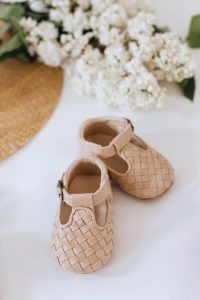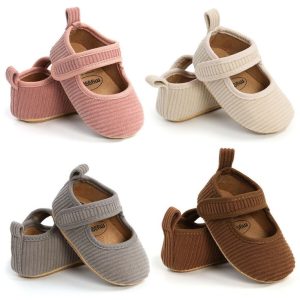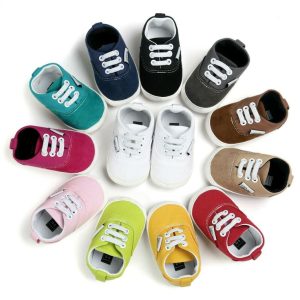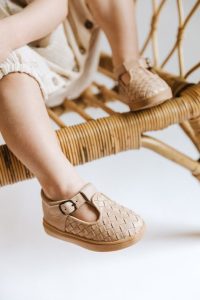Physical Address
304 North Cardinal St.
Dorchester Center, MA 02124
Physical Address
304 North Cardinal St.
Dorchester Center, MA 02124

What is the best shoe for a baby? Congratulations on your new arrival! As your baby starts to explore their world, you might wonder if they need shoes. The American Academy of Pediatrics (AAP) recommends barefoot time for babies whenever possible. This allows for healthy foot development. However, there are times when shoes might be necessary, such as when venturing outdoors or on slippery surfaces.
This article will explore the benefits of barefoot time for babies, discuss situations when shoes might be appropriate, and provide tips for choosing safe and supportive footwear for your little one.
Bare feet are great for babies’ developing feet. Here’s why:
Barefoot walking allows babies to use their toes to grip the ground, which strengthens the muscles in their feet and ankles.
Feeling the ground beneath their feet helps babies develop better balance and coordination.
Bare feet allow for a natural range of motion, which is important for healthy foot development.

What is the best shoe for a baby? While barefoot time is ideal, there are situations when shoes might be a good idea:
If you do decide to get shoes for your baby, here are some tips for choosing safe and supportive footwear:

In most cases, barefoot time is the best way for babies to develop healthy, strong feet. Shoes are not necessary for pre-walkers and should only be used when needed for protection. When choosing shoes, focus on fit, flexibility, and good traction.
Remember, the AAP recommends barefoot time whenever possible. If you have any questions about your baby’s foot development, talk to your pediatrician.
There are times when shoes might be necessary, but oftentimes, socks can be a good alternative, especially for pre-walkers. Here’s why:

If you have any concerns about your baby’s feet or development, talk to your doctor. They can assess your baby’s individual needs and provide guidance on footwear or any other questions you may have.
So, barefoot time is generally best for babies, but there are times when shoes may be necessary. Here’s a quick recap to help you decide:
Barefoot Time Whenever Possible: This allows for natural foot development and strengthens muscles.
Shoes for Protection: Shoes can be helpful outdoors, in extreme weather, or on rough or slippery surfaces.
Focus on Fit and Function: Choose soft, flexible shoes with good traction when needed.
Remember, prioritizing barefoot time is key for healthy foot development. If you have any questions about your baby’s specific needs, consult a pediatrician. They can provide personalized advice on footwear and overall development.

Babies learn and explore the world through their senses, and their feet are no exception. Barefoot time allows them to feel different textures and surfaces, which helps with sensory development and strengthens the muscles in their feet and ankles. Here are some fun barefoot activities for your little one:
What is the best shoe for a baby? Shoes become important when venturing outdoors or when extra protection is needed. Here are some tips for choosing safe shoes for those times:

While shoes serve a purpose for outdoor adventures and protection, barefoot time is generally the best way for babies to develop strong, healthy feet. By incorporating barefoot activities and prioritizing safe shoe selection when needed, you can help your baby explore their world comfortably and confidently.